Often when designing a new workplace, a company can get caught up on an idea such as open-plan or a fuse ball table in the corner and lose sight of the big picture. A workplace design must work for all employees, and align with the company’s brand and values, as well as its business objectives and goals.
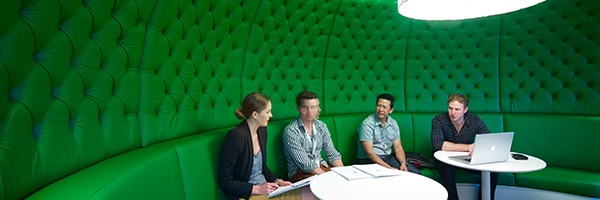
From our experience here are a few design mistakes to avoid,
-
Not Listening to or Engaging Employees
The biggest mistake to avoid when designing a new workplace is not speaking with employees well in advance of beginning the design process and not gaining an accurate understanding of employee’s current and future needs. Vague ideas are further exacerbated by not obtaining an understanding of what does and doesn’t work in your current workplace.
Are you aware of your company’s workplace design performance gaps? All too often a new workplace is designed without using data to identify a company’s strengths and weaknesses concerning workplace performance.
Performance gaps could include:
- Environmental – lack of natural light, heating and lighting
- Privacy – lack of visual/acoustic privacy
- Amenity – lack of adequate kitchen, showers or breakout space
- Flexibility – lack of room for growth, re-structures
- Interactivity – lack of opportunities to meet colleagues formal or informal settings
Further to this is not including staff in the design process. Employees who feel connected and proud of the company they work for will be more productive and generally stay longer. According to LinkedIn’s latest survey, ‘cultivating an environment where all employees feel like they belong is the secret weapon for retention.’1
Your design should support all employees and work styles – not just extroverts or Millennials. Your company could soon have four generations working together:
Your design should support all employees and work styles – not just extroverts or Millennials. Your company could soon have four generations working together:
- Gen Z, iGen, or Centennials: Born 1996 and later
- Millennials or Gen Y: Born 1977 to 1995
- Generation X: Born 1965 to 1976
- Baby Boomers: Born 1946 to 19642
A workplace design must cater to all work styles such as deskbound employees, highly mobile sales reps, as well as those that need to undertake quiet, concentrated work. If you don’t cater to all work styles and personality types you are at risk of disengaged staff.
‘Disengaged workers had 37% higher absenteeism, 49% more accidents,
and 60% more errors and defects.’3
Our work styles video outlines the common corporate work styles.
-
Too Many Gimmicks
As mentioned above there is currently a big focus on Millennials entering the workforce and that competition to attract and retain the best talent heating up. So, it may appear incorporating gimmick type design trends like slides, game rooms and chillout zones are essential. However, research now indicates these types of inclusions aren’t as appealing as first thought.
LinkedIn’s survey states, ‘while people generally love the idea of perks like free food and game rooms, our research shows this is actually one of the least enticing factors for keeping professionals at their current companies (19%)’4
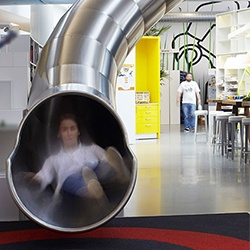 While a slide might work at the Lego office in Denmark, there isn’t a slide in sight in the, 'most popular offices of 2017 from Office Snapshots.' The standouts from these offices are open collaboration areas, colour and plant life.
While a slide might work at the Lego office in Denmark, there isn’t a slide in sight in the, 'most popular offices of 2017 from Office Snapshots.' The standouts from these offices are open collaboration areas, colour and plant life.
Our advice: Do not incorporate elements just because they are on trend. Ensure all interior design features tie in with your overall design concept and company values. Don’t overdo it; you don’t want your new finished workplace to look over the top.
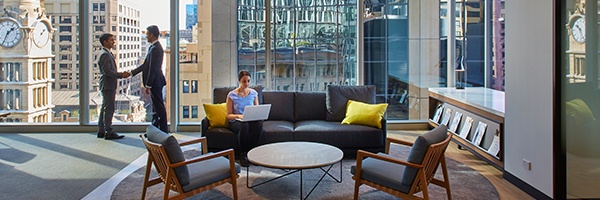
-
Taking a One-Size-Fits-All Approach
A statement we often repeat at PCG is ‘one size does NOT fit all.’ A blanket solution to office design is not the way to go to, whether you would like to move from enclosed offices to open plan or move to an agile approach, in almost all cases a hybrid design that caters to all work styles is best.
Common Mistakes:
- Creating an open plan design without space for quiet, concentrated work
- Inhibiting interaction between departments, therefore creating disjointed movement and flow
- Adopting an Activity Based Working (ABW) or Agile environment and not educating users on how to make the best use of the space
- Design the new space for one work style or personality type, e.g. extroverts
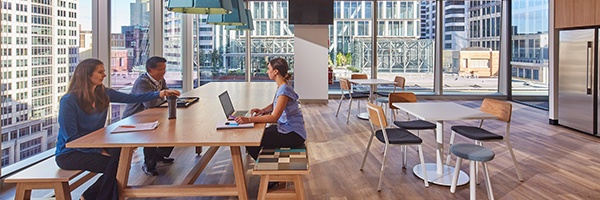
-
Ignoring the Basics
It may seem obvious, but many offices aren’t designed to optimise how an employee or client feels within a space – you need to eliminate dark, or cramped, or even claustrophobic spaces and ensure adequate natural light and sufficient air quality.
Lighting
As our blog, ‘The Future of Modern Office Design,’ states – natural light is key to any workplace as it can boost people’s energy. However, it’s not just natural light that can play a part in designing your new office space, think about your home; it most likely has multiple light sources to create different ambience and mood, and so to should your office design.
Acoustics
A delicate balance is needed to get acoustics right for your employees and visitors. If you are adopting an open plan environment, you need to ensure adequate use of relevant materials to minimise noise levels. It’s also essential to ensure your space isn’t too quiet. Have you ever been in an office that’s dead quiet? It’s not a comfortable place to be. If your space is too quiet staff won’t feel comfortable when needing to have private conversations. A reasonable level of background noise can help with concentration.
Storage
Most people would think lots of storage is key to any new design and while you do need to ensure adequate storage space for now and the future, it’s also important to take stock and evaluate how much storage is required. People tend to overestimate how much storage space they require and quite often keep hold of things they don’t need. Our advice – go paperless where you can and minimise waste before moving locations.
Reception Area
Again, it may seem obvious, but first impressions do count. A reception area should be easy to navigate for visitors and should reflect your company’s brand and values.
Avoiding these common design mistakes will go a long way in helping you achieve your design goals, however, don’t expect change because of a new design. You need to manage the change process with your employees to truly transform your workplace.
If you would like any further information on workplace design, please don’t hesitate to contact us.
For further details on assessing your current workplace download our free whitepaper, 'Is Your Workplace an Asset or Liability?'
You May Also Like:
- The Truth About Activity Based Working in 4 Minutes
- Towards 2020 – Workplace Predictions
- Check-in And Check-out is Workplace Design is Headed
Acknowledgements
1. LinkedIn 2018, ‘Workplace Culture Trends: The Key to Hiring (and Keeping) Top Talent in 2018’ Viewed June 2018 <https://blog.linkedin.com/2018/june/26/workplace-culture-trends-the-key-to-hiring-and-keeping-top-talent>.2. The Center for Generational Kinetics 2016, Generational Breakdown: Info About All of the Generations, viewed June 2018 <http://genhq.com/faq-info-about-generations/>.
3. Gallup, viewed June 2018 <www.gallup.com>.
4. LinkedIn 2018, ‘Workplace Culture Trends: The Key to Hiring (and Keeping) Top Talent in 2018’ Viewed June 2018 <https://blog.linkedin.com/2018/june/26/workplace-culture-trends-the-key-to-hiring-and-keeping-top-talent>.







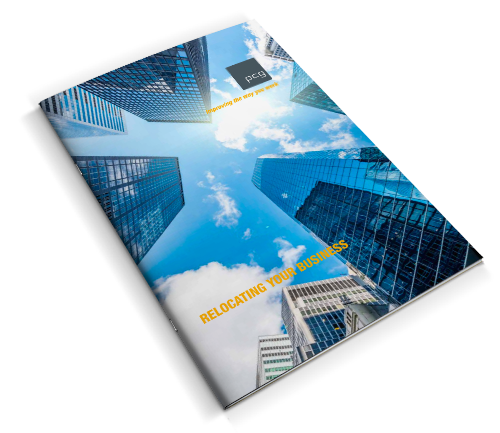


Share your thoughts